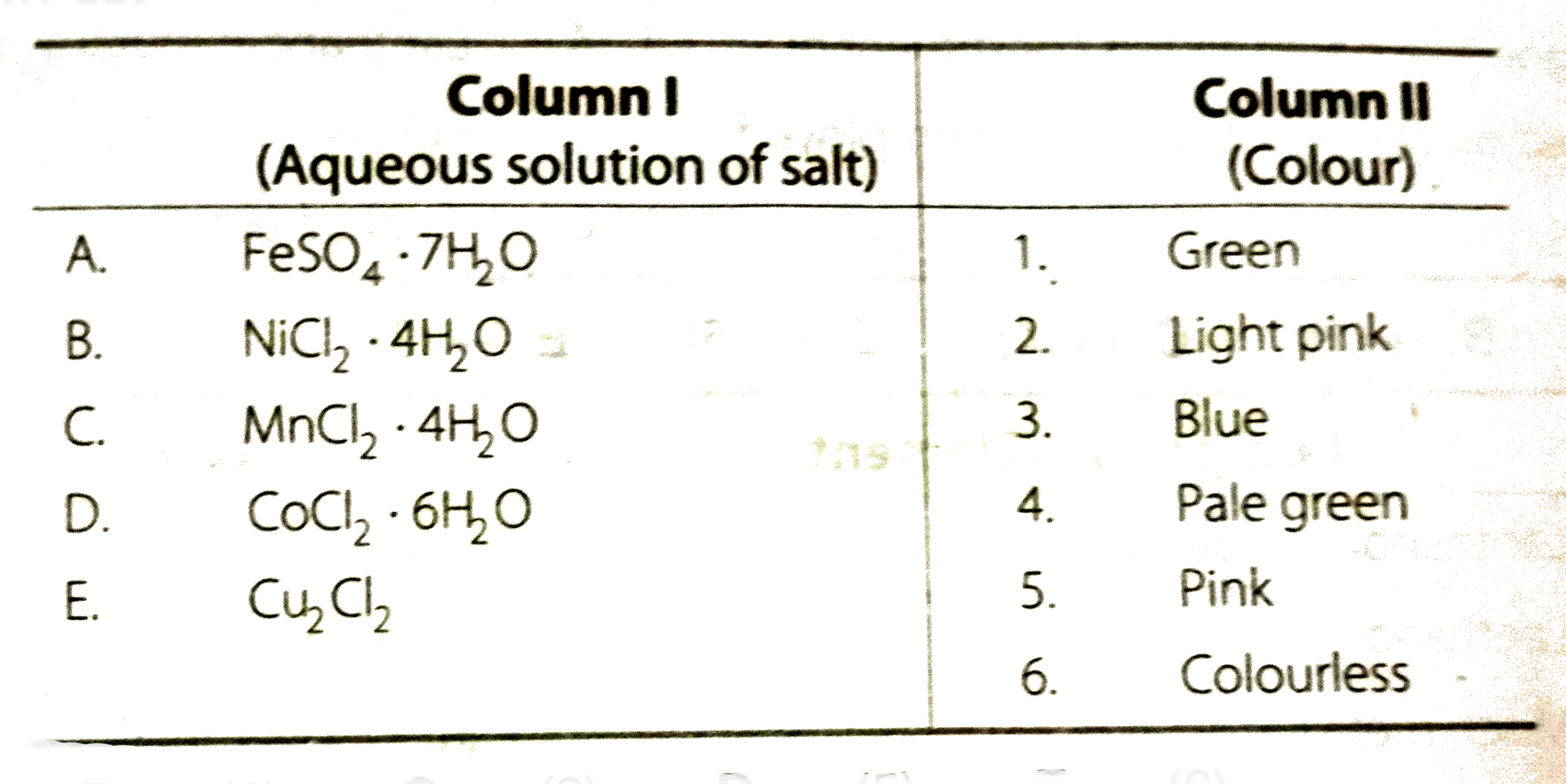Match the Column-I with Column-II:
Column-IColumn-II(A)Vapour pressure of solution(p)Mole fraction of solute(B)Lowering in vapour pressure in solution(q)Mole fraction of solvent(C)Acetone−CHCl3 solution(r)ΔHmixing=+ve(D)Hexane-ethanol solution(s)ΔHmixing=−ve(t)Non-ideal solution
To match Column-I with Column-II, we need to analyze each item in Column-I and find the corresponding item in Column-II based on the principles of vapor pressure and solution behavior.
1. Analyzing A: Vapour pressure of solution
- The vapor pressure of a solution is directly proportional to the mole fraction of the solvent (not the solute). According to Raoult's Law, the vapor pressure of a solvent in a solution is equal to the vapor pressure of the pure solvent multiplied by the mole fraction of the solvent in the solution.
- Match: A → q (Mole fraction of solvent)
2. Analyzing B: Lowering in vapour pressure in solution
- The lowering of vapor pressure occurs when a non-volatile solute is added to a solvent. This lowering is directly proportional to the mole fraction of the solute in the solution.
- Match: B → p (Mole fraction of solute)
3. Analyzing C: Acetone-CHCl3 solution
- Acetone (C3H6O) and chloroform (CHCl3) form a solution that exhibits hydrogen bonding. The formation of hydrogen bonds releases energy, indicating that the mixing process is exothermic, leading to a negative ΔH (enthalpy change).
- Match: C → s (ΔH(mixing) = -ve)
4. Analyzing D: Hexane-ethanol solution
- When hexane (C6H14) is mixed with ethanol (C2H5OH), the hydrogen bonding in ethanol is disrupted. This process requires energy, indicating that the mixing is endothermic, leading to a positive ΔH.
- Match: D → r (ΔH(mixing) = +ve)
Final Matches:
- A → q
- B → p
- C → s
- D → r
- The vapor pressure of a solution is directly proportional to the mole fraction of the solvent (not the solute). According to Raoult's Law, the vapor pressure of a solvent in a solution is equal to the vapor pressure of the pure solvent multiplied by the mole fraction of the solvent in the solution.
- Match: A → q (Mole fraction of solvent)
- The lowering of vapor pressure occurs when a non-volatile solute is added to a solvent. This lowering is directly proportional to the mole fraction of the solute in the solution.
- Match: B → p (Mole fraction of solute)
- Acetone (C3H6O) and chloroform (CHCl3) form a solution that exhibits hydrogen bonding. The formation of hydrogen bonds releases energy, indicating that the mixing process is exothermic, leading to a negative ΔH (enthalpy change).
- Match: C → s (ΔH(mixing) = -ve)
- When hexane (C6H14) is mixed with ethanol (C2H5OH), the hydrogen bonding in ethanol is disrupted. This process requires energy, indicating that the mixing is endothermic, leading to a positive ΔH.
- Match: D → r (ΔH(mixing) = +ve)
- A → q
- B → p
- C → s
- D → r
Similar Questions
Relative loweringof vapour pressure of a dilute solution is 0.2. What is the mole fraction of non-volatile solute ?
View SolutionMatch the Column-I with Column-II :
Column-IColumn-II(a)Mole fraction(p)mol kg−1(b)Molality(q)Depends on temperature(c)Molarity(r)Unitless(d)Normality(s)Independent of temperature
View Solution
Knowledge Check
Match the colume I with column II and mark the appropriate choice.
Column IColumn II(A)Liquid⇐====================⇒Vapour(i)Saturated solution(B)Splid⇐====================⇒Liquid(ii)Boiling point(C)Solid⇐====================⇒Vapour(iii)Sublimation point(D)Solute(s)⇐====================⇒Solute(solution)(iv)Melting pointA(A)→(i),(B)→(iii),(C)→(ii),(D)→(iv)B(A)→(ii),(B)→(iv),(C)→(iii),(D)→(i)C(A)→(iv),(B)→(ii),(C)→(i),(D)→(iii)D(A)→(iii),(B)→(iv),(C)→(ii),(D)→(i)
Match the Column -I with Column-II:
Column-IColumn-II(A)Raults law(p)Method for determination of osmotic pressure(B)Henris law(q)Method for determination of relative lowering in vapour pressure(C)Barkeley & Hartley(r)Effect of Pressure on solubility of gas in liquids(D)Ostwaid and Walker's method(s)P0XA=PA(t)P∘−PP0=nn+N
View SolutionThe vapour pressure of a pure liquid at 25∘C is 100 mm Hg. Calculate the relative lowering of vapour pressure if the mole fraction of solvent in solution is 0.8.
View SolutionMatch the solutions given in Column I and the colours given in Column II.

View SolutionColumn IColumn II(A)Osmotic pressure(p)Depends upon nature of solute(B)Greater lowering in vapour pressure(q)Kb(C)ΔTf(r)Movement of solvent particles from higher vapour pressure region to lower vapour pressure region through SPM(D)ΔTb(s)Increases osmotic pressure largely
View SolutionMatch the Column- I with Column- II:
Column-IColumn-II(A)0.21mCa3(PO4)2(p)Solution with highest boiling point(B)0.1mNaCl(q)Solution with van't Hoff factor greater than 1(C)0.1mglucose(r)Solution with lowest osmotic pressure(d)0.1mCaCl2(s)Solution with lowest freezing point(t)Van't Hoff factors(1+2α)
View SolutionLowering of vapour pressure of an aqueous solution of a non-volatile non-electrolyte 1 m aqueous solution at 100∘C is,
View SolutionThe vapour pressure of water at room temperature is 23.8 mm Hg. The vapour pressure of an aqueous solution of sucrose with mole fraction 0.1 is equal to
View Solution